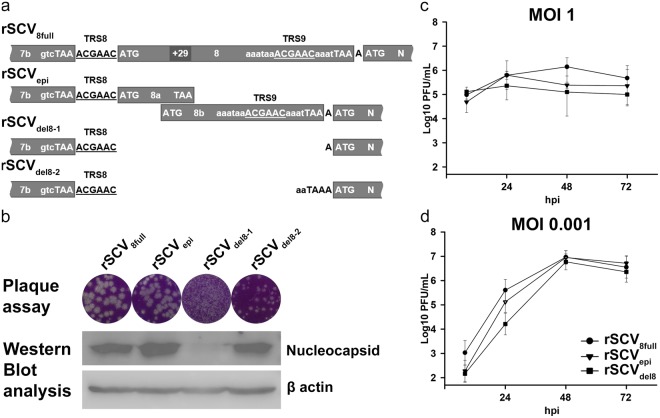Figure 1.
Generation and evaluation of ORF8 variant recombinant SARS-CoV. Variants of the open reading frame 8 (ORF8) were designed in accordance to their appearance in nature. (a) rSCV8full represents a single ORF8 as found in reservoir bats and amplification hosts in China, as well as in the early phase of the SARS epidemic. The middle phase of the epidemic was dominated by a virus variant carrying a 29 nt deletion resulting in the disruption of ORF8 in 2 reading frames, 8a and 8b, as seen in rSCVepi. The absence of ORF8 is a genomic feature of reservoir bats in Europe and the epidemic virus in the late phase. Two deletion variants were constructed. Variant 1, rSCVdel8–1, perfectly misses ORF8. In variant 2, rSCVdel8–2, ORF8 is replaced by the short substitutional sequence AATAA in accordance to the upstream region of the nucleocapsid gene of the European SARS-related bat-CoV BtCoV/BM48–31/Rhi bla/Bulgaria/2008 (NC_014470). (b) Plaque morphology of rSCV8full and rSCVepi were very similar, while rSCVdel8–1 produced only diffuse and rSCVdel8–2 reduced plaques. Western Blot analysis revealed that only rSCV8full, rSCVepi, and rSCVdel8–2 infected cells expressed the nucleocapsid protein, while none could be detected in cells infected with rSCVdel8–1. Detection of β actin served as loading control. Virus replication of the three ORF8 variants, (rSCVdel8 = rSCVdel8–2) was monitored by plaque titration after infection of VeroFM cells at two different multiplicities of infection, 1 (c) and 0.001 (d). Virus growth was determined in at least 3 independent experiments in triplicates. Shown is one representative experiment. Error bars represent standard deviation of the mean.

